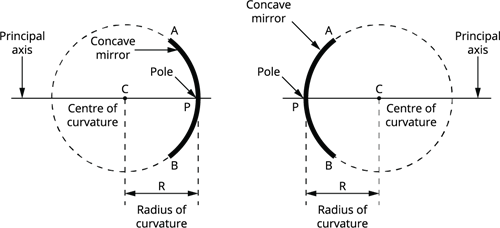
PUMPA - SMART LEARNING
எங்கள் ஆசிரியர்களுடன் 1-ஆன்-1 ஆலோசனை நேரத்தைப் பெறுங்கள். டாப்பர் ஆவதற்கு நாங்கள் பயிற்சி அளிப்போம்
Book Free DemoSpherical mirrors are a part of a sphere. Consider a sphere that is hollow in nature. Consider slicing a portion of a sphere and silvering the surface of the portions on the inner or outer surface, as shown in the below diagram.

If a mirror is obtained from a sphere silvered on the outer side, it is called a concave mirror.
If a mirror is obtained from a silvered sphere inside, it is called a convex mirror.
Terms related to spherical mirrors:
Length AB is the measure of aperture, C is the centre of curvature, P is the pole, and PC is the principal axis.

Important terms of spherical mirror
Aperture: The portion available for reflection is called aperture; APB is the aperture.
Pole: It is the geometric centre of the reflecting surface. It is denoted by P.
Centre of Curvature: It is the centre of the sphere of which the mirror forms a part. C is the centre of curvature.
Principal Axis: It is a straight line passing through the centre of curvature and the pole. The line passing through P and C in the figure is the principal axis.
Radius of Curvature (R): It is the radius of the sphere of which the mirror forms a part. PC is the radius of curvature.
Principal Focus: Consider a parallel beam of light incident on a spherical mirror,
In the case of a concave mirror, the parallel beam after reflection converges at a point F which is called the principal focus.
In the case of a convex mirror, it appears to diverge from the focus (F).
Thus, a concave mirror is called a converging mirror, and a convex mirror is called a diverging mirror.
Focal Length: It is the distance between the pole and the principal focus. PF is the focal length. It is denoted by ‘f’. It is measured in m or cm.